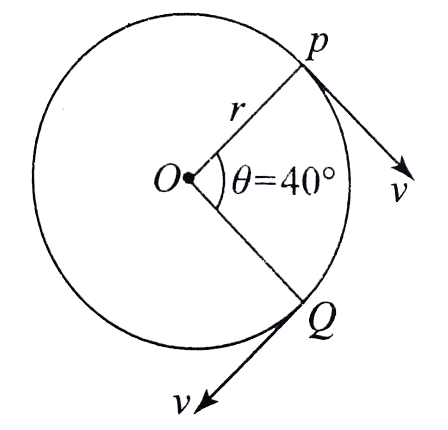A particle is moving on a circular path of radius r with uniform speed v. What is the displacement of the particle after it has described an angle of 60∘?
r√2
r√3
r
2r
The correct Answer is:C
To find the displacement of a particle moving along a circular path of radius r after it has described an angle of 60∘, we can follow these steps:
Step 1: Understand the Geometry
The particle starts at point A on the circumference of the circle and moves to point B after subtending an angle of 60∘. The displacement is the straight-line distance between points A and B.
Step 2: Draw the Circle and Points
Draw a circle with radius r. Mark point A at the starting position and point B at the position after moving 60∘ around the circle.
Step 3: Use the Cosine Rule
To find the displacement x (the straight line distance between points A and B), we can use the cosine rule in triangle OAB, where O is the center of the circle:
x2=OA2+OB2−2⋅OA⋅OB⋅cos(θ)
Here, OA=OB=r (the radius of the circle) and θ=60∘.
Step 4: Substitute Values into the Cosine Rule
Substituting the values into the cosine rule:
x2=r2+r2−2⋅r⋅r⋅cos(60∘)
Since cos(60∘)=12:
x2=r2+r2−2⋅r2⋅12
x2=r2+r2−r2
x2=r2
Step 5: Solve for Displacement
Taking the square root of both sides gives:
x=r
Conclusion
The displacement of the particle after it has described an angle of 60∘ is r.
Final Answer
The displacement is r.
---
The particle starts at point A on the circumference of the circle and moves to point B after subtending an angle of 60∘. The displacement is the straight-line distance between points A and B.
Draw a circle with radius r. Mark point A at the starting position and point B at the position after moving 60∘ around the circle.
To find the displacement x (the straight line distance between points A and B), we can use the cosine rule in triangle OAB, where O is the center of the circle:
x2=OA2+OB2−2⋅OA⋅OB⋅cos(θ)
Here, OA=OB=r (the radius of the circle) and θ=60∘.
Substituting the values into the cosine rule:
x2=r2+r2−2⋅r⋅r⋅cos(60∘)
Since cos(60∘)=12:
x2=r2+r2−2⋅r2⋅12
x2=r2+r2−r2
x2=r2
Taking the square root of both sides gives:
x=r
The displacement of the particle after it has described an angle of 60∘ is r.
The displacement is r.
Topper's Solved these Questions
- MOTION IN A PLANE BOOK - NCERT FINGERTPS ENGLISHCHAPTER - MOTION IN A PLANE EXERCISE - HOTS
6 Videos
- MOTION IN A PLANE BOOK - NCERT FINGERTPS ENGLISHCHAPTER - MOTION IN A PLANE EXERCISE - EXEMPLER PROBLEMS
9 Videos
- MECHANICAL PROPERTIES OF SOLIDSBOOK - NCERT FINGERTPS ENGLISHCHAPTER - MECHANICAL PROPERTIES OF SOLIDSEXERCISE - Assertion And Reason
15 Videos
- MOTION IN A STRAIGHT LINEBOOK - NCERT FINGERTPS ENGLISHCHAPTER - MOTION IN A STRAIGHT LINEEXERCISE - NCERT Exemplar
6 Videos
Similar Questions
Knowledge Check
A particle is moving on a circular path of radius R with constant speed v. During motion of the particle form point A to point B
 AAverage speed is v/2BThe magnitude of average velocity is v/πCThe magnitude of average acceleration is 2v2πRDAverage velocity is zero.
AAverage speed is v/2BThe magnitude of average velocity is v/πCThe magnitude of average acceleration is 2v2πRDAverage velocity is zero.A particle is moving in a circle with uniform speed. IT has constant
AvelocityBAccelerationCkinetic energyDdisplacement
A particle moves in a circular path with a uniform speed. Its motion is
View SolutionA particle is moving on a circular path with constant speed v. The magnitude of the change in its velocity after it has described an angle of 90∘ is :
View Solution
A particle is moving on a circular path of radius r with uniform velocity v. The change in velocity when the particle moves from P to Q is (∠POQ=40∘)
View SolutionA particle is moving along a circular path of radius 5 m with a uniform speed 5ms−1. What will be the average acceleration when the particle completes half revolution?
View SolutionA particle is moving in a circular path of radius r. The displacement after half a circle would be
View SolutionA particle is moving on a circular path with constant speed v then the change in its velocity after it has described an angle of 60∘ will be
View Solution
